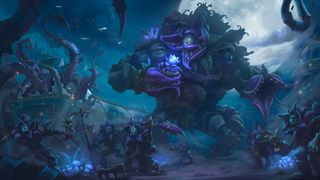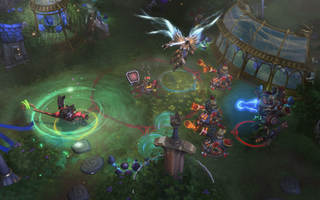Garden of Terror is one the best maps in Heroes of the Storm

Heroes of the Storm players are divided on a lot of questions. Is it acceptable to use quick-match mode to learn new heroes and tactics, or are you wasting everyone’s time by not coming ultra-prepared and treating every match like Serious Business? Should tricky characters like Nova be available as part of the free rotation to all players, regardless of skill level? Are there too many characters from someone else’s favorite Blizzard game and not enough from mine? (The answer to that one is always “yes” and on a related note, where’s Kyle from Blackthorne, Blizzard?) But one of the most divisive questions of all is whether the Garden of Terror is a terrible map, or actually a totally rad one.
If you’re not familiar with it, the Garden is a map ruled by a Spore Queen who has the unusual idea of recruiting heroes from multiple dimensions to help her with the weeding by promising that if they collect 100 seeds from the horror plants that appear in her garden overnight she’ll let them grow a gigantic weed monster of their own and use it to destroy their enemies. I hate yard work too, but this seems like a pretty inefficient system to me.
One of the things the Garden of Terror cops a lot of flak for is being a large map—three lanes with a lot of space between them—and encouraging longer games. I get that; one of the things about Heroes of the Storm that gives it appeal over Dota 2 or League of Legends is that you can finish a round before your will to live ebbs away. But another thing that makes it appealing is that comebacks are possible—and even if some matches there are a whole five minutes longer, the Garden of Terror is a great map for comebacks.

Once a team collects 100 seeds, a Garden Terror begins growing in the fertile soil within their base. Unlike the Grave Golems that spawn on the Haunted Mines map, you have to march your giant plant-monster all the way across the battleground every time rather than picking up from where it left off, which reduces the advantage a single solid push can grant. The Haunted Mines may be a quick, two-lane map but it’s also one where early advantage almost always translates into a win. And unlike the Garden Terror, no one gets to control the Grave Golems but the computer.
There are plenty of maps in Heroes of the Storm that revolve around powering up big dudes to attack enemy defenses for you, and that can feel like it sidelines the players. A demon or an angel or whatever does the actual damage while you wave pom-poms and shout, “Go team Burning Hells!” Only two of these monsters are controlled by players: the Dragon Knight from the Dragon Shire map, who breathes fire and punts heroes into the air, and the Garden Terror. A huge, green, venus flytrap-headed tendril beast. It’s a bundle of hit points and weird abilities that feels very different to play from regular heroes, especially compared to someone fragile like tiny Murky.
The Garden Terror has three abilities: a charge move, a potted plant that puts down roots to disable defenses as well as damaging both them and nearby minions, and a second potted plant that transforms enemy heroes into plants themselves, unable to attack or use abilities for a duration. Unlike the Dragon Knight, which has a damage bonus against buildings, the Garden Terror is worth using against heroes, though the arguments in team-chat about whether that’s a good idea or not show it’s just as divisive as the question of whether this map is any good.

The Terror’s damage output increases over the course of a game to match heroes as they level (you can check this by pressing C while controlling it; instead of bringing up your regular character sheet it will show the plant’s). It’s especially useful against heroes who try to use the distraction of the seed-chasing night phase to recruit mercenaries. A lot of players don’t realize its overgrowth ability damages minions as well as towers, and if opponents are pushing forward with mercs a single overgrowth pot can wipe out an entire wave of them. And of course there’s the Curse of the Spore Queen, the attack that zombifies heroes and changes them into cute miniaturized versions of Audrey from Little Shop Of Horrors, ripe for stomping.
PC Gamer Newsletter
Sign up to get the best content of the week, and great gaming deals, as picked by the editors.
If you do go for towers instead of heroes, there’s the choice of whether to place your overgrowth pot on the far side of the wall, where it will reach more buildings but might be destroyed before it’s had a chance to damage them, or plonk it down on the near side of the wall where it can be defended, even shielding it yourself if necessary. Furthermore you can stick with attacking one set of defenses or drop a pot and then use the charge move to sprint to the next, harassing multiple targets and forcing defenders to split their attention.
These decisions are what makes the Garden of Terror such an interesting map. More choices open up the more you learn about how the map works, and a surprising number of them are valid. I’ve even seen teams use the Terror to help gather more seeds, denying their opponents while speeding the growth of their next Terror, and it worked just fine.

Some maps force you to play a certain way, or simply don’t offer many options—the way Tomb of the Spider Queen’s objective can be completed while still pushing lanes for instance—and others make teamfights so frequent that only heroes built for them feel useful, as in the cramped Haunted Mines. In the relatively spacious Garden there’s room for multiple playstyles and tactics, allowing abilities like E.T.C.’s Stage Dive—which lets the heavy metal minotaur leap any distance—to potentially come into their own.
Another part of why I enjoy the Garden of Terror is that it’s well-themed. While similar in layout to Dragon Shire—there’s even an overgrown Dragon Knight statue to the north as a nod to this—the day/night cycle and the Muppety flower-headed Shambler weeds gives it an identity of its own. Plus the voice actor who plays the Spore Queen hams it up gloriously, wailing like a banshee. She doesn’t go quite as far over-the-top as Captain Blackheart’s “arr matey” pirate impersonation, but her ranting and cries of “Kill! Fight! Spread my spores!” are agreeably demented.
The Heroes of the Storm community is as obsessed with finding the one true way to play as the community of any competitive game, but the Garden of Terror demonstrates that this is a game where sticking to the playbook you read on a wiki isn’t always the best idea. One of the strengths of Heroes of the Storm is that repeating the obvious strategy isn’t always the best thing to do, and surprises and turnarounds can happen if you let them.

Jody's first computer was a Commodore 64, so he remembers having to use a code wheel to play Pool of Radiance. A former music journalist who interviewed everyone from Giorgio Moroder to Trent Reznor, Jody also co-hosted Australia's first radio show about videogames, Zed Games. He's written for Rock Paper Shotgun, The Big Issue, GamesRadar, Zam, Glixel, Five Out of Ten Magazine, and Playboy.com, whose cheques with the bunny logo made for fun conversations at the bank. Jody's first article for PC Gamer was about the audio of Alien Isolation, published in 2015, and since then he's written about why Silent Hill belongs on PC, why Recettear: An Item Shop's Tale is the best fantasy shopkeeper tycoon game, and how weird Lost Ark can get. Jody edited PC Gamer Indie from 2017 to 2018, and he eventually lived up to his promise to play every Warhammer videogame.
Most Popular



